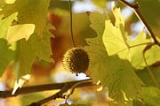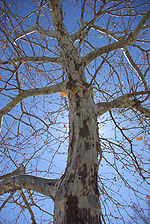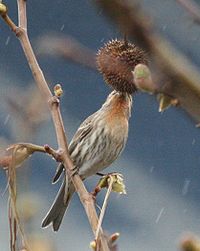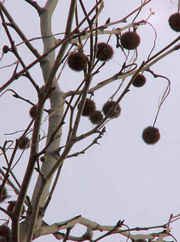
London Plane
Encyclopedia
Platanus × acerifolia, the London plane, London planetree, or hybrid plane, is a tree in the genus Platanus
. It is usually thought to be a hybrid of Platanus orientalis
(oriental plane) and the Platanus occidentalis (American sycamore). Some authorities think that it may be a cultivar
of P. orientalis.
 The London Plane is a large deciduous
The London Plane is a large deciduous
tree
growing to 20–35 m (exceptionally over 40 m) tall, with a trunk up to 3 m or more in circumference. The bark
is usually pale grey-green, smooth and exfoliating, or buff-brown and not exfoliating. The leaves
are thick and stiff-textured, broad, palmately lobed, superficially maple
-like, the leaf blade 10–20 cm long and 12–25 cm broad, with a petiole
3–10 cm long. The young leaves in spring are coated with minute, fine, stiff hairs at first, but these wear off and by late summer the leaves are hairless or nearly so. The flower
s are borne in one to three (most often two) dense spherical inflorescence
s on a pendulous stem, with male and female flowers on separate stems. The fruit
matures in about 6 months, to 2–3 cm diameter, and comprises a dense spherical cluster of achene
s with numerous stiff hairs which aid wind dispersal; the cluster breaks up slowly over the winter to release the numerous 2–3 mm seeds.
 It was first recorded as occurring in Spain
It was first recorded as occurring in Spain
in the 17th century, where the Oriental Plane and the American Plane had been planted in proximity to one another.
The leaf and flower characteristics are intermediate between the two parent species, the leaf being more deeply lobed than P. occidentalis but less so than P. orientalis, and the seed balls typically two per stem (one in P. occidentalis, 3-6 in P. orientalis). The hybrid is fertile, and seedlings are occasionally found near mature trees.
Controlled reciprocal pollinations between P. occidentalis and P. orientalis resulted in good yields of germinable seed and true hybrid seedlings. Crosses of both species, as females, with P. racemosa and P. wrightii produced extremely low yields of germinable seed, but true hybrids were obtained from all interspecific combinations. Apomixis (asexual reproduction from non-fertilized seeds) appeared common in P. orientalis.
In 1968 and 1970, Frank S. Santamour, Jr., recreated the P. orientalis, P. occidentalis cross using a P. orientalis of Turkish origin with American sycamores (P. occidentalis). The offspring were evaluated following several years of exposure to anthracnose infection. Two selections'Columbia' and 'Liberty' were released in August, 1984.
in his 1789 work Hortus Kewensis
as a variety of Platanus orientalis. Aiton described this variety with a two-word Latin diagnosis, "foliis tranſverſis" (using the long s
or "foliis transversis" without it), and called it the Spanish Plane Tree. In 1805, Carl Ludwig Willdenow
chose to elevate Aiton's variety to species rank, publishing the new species Platanus acerifolia in the fourth edition of Species Plantarum
. The species name was then modified to include the multiplication symbol to indicate its suspected hybrid parentage. The other name commonly used for this taxon, Platanus × hispanica auct. non Mill. ex Münchh., is a nomen dubium
based on an uncertain description.


but Buenos Aires
, Curitiba
, New York City
, Paris
, Madrid
, Melbourne
, Mannheim
, Shanghai
, Nanjing
, Chicago
, Sydney
, Rybnik
and many others. It has a greater degree of winter cold tolerance than the Oriental Plane, and is less susceptible to anthracnose disease than the American Plane. The seeds are used as a food source by some finch
es and squirrel
s.
The tree is fairly wind-resistant. However, it has a number of problems in urban use, most notably the short, stiff hairs shed by the young leaves and the dispersing seeds; these are an irritant if breathed in, and can exacerbate breathing difficulties for people with asthma
. The large leaves can create a disposal problem in cities. These leaves are tough and sometimes can take more than one year to break down if they remain whole.
London Planes are often pruned by a technique called pollarding
. A pollarded tree has a drastically different appearance than an unpruned tree, being much shorter with stunted, club-like branches. Although pollarding requires frequent maintenance (the trees must usually be repruned every year), it creates a distinctive shape that is often sought after in plazas, main streets, and other urban areas.
the symbol of that organisation is a cross between the leaf of the London plane and a maple leaf. It is prominently featured on signs and buildings in public parks across the city. The tree is today on the NYC Parks Department's list of restricted use trees for street tree planting.
Platanus
Platanus is a small genus of trees native to the Northern Hemisphere. They are the sole living members of the family Platanaceae....
. It is usually thought to be a hybrid of Platanus orientalis
Platanus orientalis
Platanus orientalis, or the Oriental plane, is a large, deciduous tree of the Platanaceae family, known for its longevity and spreading crown. The species name derives from its historical distribution eastward from the Balkans, where it was recognized in ancient Greek history and literature....
(oriental plane) and the Platanus occidentalis (American sycamore). Some authorities think that it may be a cultivar
Cultivar
A cultivar'Cultivar has two meanings as explained under Formal definition. When used in reference to a taxon, the word does not apply to an individual plant but to all those plants sharing the unique characteristics that define the cultivar. is a plant or group of plants selected for desirable...
of P. orientalis.
Description

Deciduous
Deciduous means "falling off at maturity" or "tending to fall off", and is typically used in reference to trees or shrubs that lose their leaves seasonally, and to the shedding of other plant structures such as petals after flowering or fruit when ripe...
tree
Tree
A tree is a perennial woody plant. It is most often defined as a woody plant that has many secondary branches supported clear of the ground on a single main stem or trunk with clear apical dominance. A minimum height specification at maturity is cited by some authors, varying from 3 m to...
growing to 20–35 m (exceptionally over 40 m) tall, with a trunk up to 3 m or more in circumference. The bark
Bark
Bark is the outermost layers of stems and roots of woody plants. Plants with bark include trees, woody vines and shrubs. Bark refers to all the tissues outside of the vascular cambium and is a nontechnical term. It overlays the wood and consists of the inner bark and the outer bark. The inner...
is usually pale grey-green, smooth and exfoliating, or buff-brown and not exfoliating. The leaves
Leaf
A leaf is an organ of a vascular plant, as defined in botanical terms, and in particular in plant morphology. Foliage is a mass noun that refers to leaves as a feature of plants....
are thick and stiff-textured, broad, palmately lobed, superficially maple
Maple
Acer is a genus of trees or shrubs commonly known as maple.Maples are variously classified in a family of their own, the Aceraceae, or together with the Hippocastanaceae included in the family Sapindaceae. Modern classifications, including the Angiosperm Phylogeny Group system, favour inclusion in...
-like, the leaf blade 10–20 cm long and 12–25 cm broad, with a petiole
Petiole (botany)
In botany, the petiole is the stalk attaching the leaf blade to the stem. The petiole usually has the same internal structure as the stem. Outgrowths appearing on each side of the petiole are called stipules. Leaves lacking a petiole are called sessile, or clasping when they partly surround the...
3–10 cm long. The young leaves in spring are coated with minute, fine, stiff hairs at first, but these wear off and by late summer the leaves are hairless or nearly so. The flower
Flower
A flower, sometimes known as a bloom or blossom, is the reproductive structure found in flowering plants . The biological function of a flower is to effect reproduction, usually by providing a mechanism for the union of sperm with eggs...
s are borne in one to three (most often two) dense spherical inflorescence
Inflorescence
An inflorescence is a group or cluster of flowers arranged on a stem that is composed of a main branch or a complicated arrangement of branches. Strictly, it is the part of the shoot of seed plants where flowers are formed and which is accordingly modified...
s on a pendulous stem, with male and female flowers on separate stems. The fruit
Fruit
In broad terms, a fruit is a structure of a plant that contains its seeds.The term has different meanings dependent on context. In non-technical usage, such as food preparation, fruit normally means the fleshy seed-associated structures of certain plants that are sweet and edible in the raw state,...
matures in about 6 months, to 2–3 cm diameter, and comprises a dense spherical cluster of achene
Achene
An achene is a type of simple dry fruit produced by many species of flowering plants. Achenes are monocarpellate and indehiscent...
s with numerous stiff hairs which aid wind dispersal; the cluster breaks up slowly over the winter to release the numerous 2–3 mm seeds.
Origin

Spain
Spain , officially the Kingdom of Spain languages]] under the European Charter for Regional or Minority Languages. In each of these, Spain's official name is as follows:;;;;;;), is a country and member state of the European Union located in southwestern Europe on the Iberian Peninsula...
in the 17th century, where the Oriental Plane and the American Plane had been planted in proximity to one another.
The leaf and flower characteristics are intermediate between the two parent species, the leaf being more deeply lobed than P. occidentalis but less so than P. orientalis, and the seed balls typically two per stem (one in P. occidentalis, 3-6 in P. orientalis). The hybrid is fertile, and seedlings are occasionally found near mature trees.
Controlled reciprocal pollinations between P. occidentalis and P. orientalis resulted in good yields of germinable seed and true hybrid seedlings. Crosses of both species, as females, with P. racemosa and P. wrightii produced extremely low yields of germinable seed, but true hybrids were obtained from all interspecific combinations. Apomixis (asexual reproduction from non-fertilized seeds) appeared common in P. orientalis.
In 1968 and 1970, Frank S. Santamour, Jr., recreated the P. orientalis, P. occidentalis cross using a P. orientalis of Turkish origin with American sycamores (P. occidentalis). The offspring were evaluated following several years of exposure to anthracnose infection. Two selections'Columbia' and 'Liberty' were released in August, 1984.
Taxonomy
Platanus × acerifolia was first formally described in the botanical literature by the Scottish botanist William AitonWilliam Aiton
William Aiton was a Scottish botanist.Aiton was born near Hamilton. Having been regularly trained to the profession of a gardener, he travelled to London in 1754, and became assistant to Philip Miller, then superintendent of the Chelsea Physic Garden...
in his 1789 work Hortus Kewensis
Hortus Kewensis
Hortus Kewensis, or a Catalogue of the Plants Cultivated in the Royal Botanic Garden at Kew by William Aiton was a 1789 catalogue of all the plant species then in cultivation at the Royal Botanic Gardens, Kew, which constituted the vast majority of plant species in cultivation in all of England...
as a variety of Platanus orientalis. Aiton described this variety with a two-word Latin diagnosis, "foliis tranſverſis" (using the long s
Long s
The long, medial or descending s is a form of the minuscule letter s formerly used where s occurred in the middle or at the beginning of a word, for example "ſinfulneſs" . The modern letterform was called the terminal, round, or short s.-History:The long s is derived from the old Roman cursive...
or "foliis transversis" without it), and called it the Spanish Plane Tree. In 1805, Carl Ludwig Willdenow
Carl Ludwig Willdenow
Carl Ludwig Willdenow was a German botanist, pharmacist, and plant taxonomist. He is considered one of the founders of phytogeography, the study of the geographic distribution of plants...
chose to elevate Aiton's variety to species rank, publishing the new species Platanus acerifolia in the fourth edition of Species Plantarum
Species Plantarum
Species Plantarum was first published in 1753, as a two-volume work by Carl Linnaeus. Its prime importance is perhaps that it is the primary starting point of plant nomenclature as it exists today. This means that the first names to be considered validly published in botany are those that appear...
. The species name was then modified to include the multiplication symbol to indicate its suspected hybrid parentage. The other name commonly used for this taxon, Platanus × hispanica auct. non Mill. ex Münchh., is a nomen dubium
Nomen dubium
In zoological nomenclature, a nomen dubium is a scientific name that is of unknown or doubtful application...
based on an uncertain description.
Cultivars and varieties


- Augustine Henry. This is a tall growing variety, with very large, pale green leaves. It produces a strong leader and a cylindrical trunk.
- Bloodgood, This is one of the first cultivars to be selected for anthracnose resistance. It is a rounded tree with deep green leaves that turn a poor yellow in fall. The plant tolerates poor cultural conditions, including heat, drought and poor soil. Recent observations indicate susceptibility to ozone.
- Columbia. Resists mildew and anthracnose, this tree has deeply-lobed, dark green leaves.
- Liberty. A U.S. National Arboretum introduction, this pyramidal tree grows vigorously. It shows good tolerance for mildew, anthracnose, heat and drought.
- Metzam (Metroshade), A new introduction that grows strongly with a pyramidal habit, this cultivar is also said to be disease resistant with lustrous green foliage that emerges with a reddish cast.
- Mirkovec. Has a dwarf, shrubby habit and unusual variegated lobed leaves with pink, cream and bronze regions.
- Pyramidalis. A cultivar or cultivar group common in London, with rich glossy green leaves, and a characteristic tendency to produce straight branches, compared to sinuous ones in other forms.
- Suttneri. Leaves are variegated creamy white.
- Yarwood. Very resistant to powdery mildew and highly susceptible to anthracnose. Poor structure. Being abandoned in California.
Use
The London plane is very tolerant of atmospheric pollution and root compaction, and for this reason it is a popular urban roadside tree. It is now extensively cultivated in most temperate latitudes as an ornamental and parkland tree, and is a commonly planted tree in cities throughout the temperate regions of the world, not just LondonLondon
London is the capital city of :England and the :United Kingdom, the largest metropolitan area in the United Kingdom, and the largest urban zone in the European Union by most measures. Located on the River Thames, London has been a major settlement for two millennia, its history going back to its...
but Buenos Aires
Buenos Aires
Buenos Aires is the capital and largest city of Argentina, and the second-largest metropolitan area in South America, after São Paulo. It is located on the western shore of the estuary of the Río de la Plata, on the southeastern coast of the South American continent...
, Curitiba
Curitiba
Curitiba is the capital of the Brazilian state of Paraná. It is the largest city with the biggest economy of both Paraná and southern Brazil. The population of Curitiba numbers approximately 1.75 million people and the latest GDP figures for the city surpass US$61 billion according to...
, New York City
New York City
New York is the most populous city in the United States and the center of the New York Metropolitan Area, one of the most populous metropolitan areas in the world. New York exerts a significant impact upon global commerce, finance, media, art, fashion, research, technology, education, and...
, Paris
Paris
Paris is the capital and largest city in France, situated on the river Seine, in northern France, at the heart of the Île-de-France region...
, Madrid
Madrid
Madrid is the capital and largest city of Spain. The population of the city is roughly 3.3 million and the entire population of the Madrid metropolitan area is calculated to be 6.271 million. It is the third largest city in the European Union, after London and Berlin, and its metropolitan...
, Melbourne
Melbourne
Melbourne is the capital and most populous city in the state of Victoria, and the second most populous city in Australia. The Melbourne City Centre is the hub of the greater metropolitan area and the Census statistical division—of which "Melbourne" is the common name. As of June 2009, the greater...
, Mannheim
Mannheim
Mannheim is a city in southwestern Germany. With about 315,000 inhabitants, Mannheim is the second-largest city in the Bundesland of Baden-Württemberg, following the capital city of Stuttgart....
, Shanghai
Shanghai
Shanghai is the largest city by population in China and the largest city proper in the world. It is one of the four province-level municipalities in the People's Republic of China, with a total population of over 23 million as of 2010...
, Nanjing
Nanjing
' is the capital of Jiangsu province in China and has a prominent place in Chinese history and culture, having been the capital of China on several occasions...
, Chicago
Chicago
Chicago is the largest city in the US state of Illinois. With nearly 2.7 million residents, it is the most populous city in the Midwestern United States and the third most populous in the US, after New York City and Los Angeles...
, Sydney
Sydney
Sydney is the most populous city in Australia and the state capital of New South Wales. Sydney is located on Australia's south-east coast of the Tasman Sea. As of June 2010, the greater metropolitan area had an approximate population of 4.6 million people...
, Rybnik
Rybnik
Rybnik is a city in southern Poland, in the Silesian Voivodeship. Rybnik is located close to the border with the Czech Republic and just outside the southern border of the largest urban area in Poland, the Upper Silesian Metropolitan Union...
and many others. It has a greater degree of winter cold tolerance than the Oriental Plane, and is less susceptible to anthracnose disease than the American Plane. The seeds are used as a food source by some finch
Finch
The true finches are passerine birds in the family Fringillidae. They are predominantly seed-eating songbirds. Most are native to the Northern Hemisphere, but one subfamily is endemic to the Neotropics, one to the Hawaiian Islands, and one subfamily – monotypic at genus level – is found...
es and squirrel
Squirrel
Squirrels belong to a large family of small or medium-sized rodents called the Sciuridae. The family includes tree squirrels, ground squirrels, chipmunks, marmots , flying squirrels, and prairie dogs. Squirrels are indigenous to the Americas, Eurasia, and Africa and have been introduced to Australia...
s.
The tree is fairly wind-resistant. However, it has a number of problems in urban use, most notably the short, stiff hairs shed by the young leaves and the dispersing seeds; these are an irritant if breathed in, and can exacerbate breathing difficulties for people with asthma
Asthma
Asthma is the common chronic inflammatory disease of the airways characterized by variable and recurring symptoms, reversible airflow obstruction, and bronchospasm. Symptoms include wheezing, coughing, chest tightness, and shortness of breath...
. The large leaves can create a disposal problem in cities. These leaves are tough and sometimes can take more than one year to break down if they remain whole.
London Planes are often pruned by a technique called pollarding
Pollarding
Pollarding is a pruning system in which the upper branches of a tree are removed, promoting a dense head of foliage and branches. It has been common in Great Britain and Europe since medieval times and is practiced today in urban areas worldwide, primarily to maintain trees at a predetermined...
. A pollarded tree has a drastically different appearance than an unpruned tree, being much shorter with stunted, club-like branches. Although pollarding requires frequent maintenance (the trees must usually be repruned every year), it creates a distinctive shape that is often sought after in plazas, main streets, and other urban areas.
Trivia
According to Lois Nam of the New York City Department of Parks and RecreationNew York City Department of Parks and Recreation
The City of New York Department of Parks & Recreation is the department of government of the City of New York responsible for maintaining the city's parks system, preserving and maintaining the ecological diversity of the city's natural areas, and furnishing recreational opportunities for city's...
the symbol of that organisation is a cross between the leaf of the London plane and a maple leaf. It is prominently featured on signs and buildings in public parks across the city. The tree is today on the NYC Parks Department's list of restricted use trees for street tree planting.
Further reading
- Bean. Trees and Shrubs hardy in the British Isles. (8th ed., 1976)
- Huxley, A., ed. (1992). New RHS Dictionary of Gardening. Macmillan.
- Rushforth, K. (1999). Trees of Britain and Europe. Harper Collins ISBN 0-00-220013-9.
- Interspecific Hybridization in Platanus. Author: Santamour, Frank S.1. Source: Forest Science, Volume 18, Number 3, 1 September 1972, pp. 236–239(4) Publisher: Society of American Foresters

